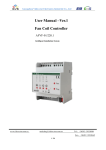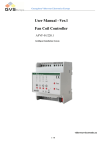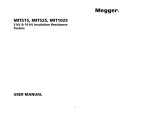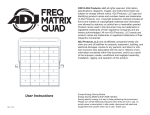Download ParSec Data Display & Entry Panel (DDE) INSTALLATION & USER
Transcript
ParSec Data Display & Entry Panel (DDE) INSTALLATION & USER MANUAL This page is intentionally blank ParSec Data Display & Entry Panel (DDE) INSTALLATION & USER MANUAL Part No: UM016 Document No: A/UM 230 851 Issue Draft 5 August 2000 Newmark Technology Ltd 21-23, Ormside Way Redhill Surrey RH1 2NT United Kingdom Tel: +44(0) 1737 788800 Fax: +44(0) 1737 779535 Web site: www.newmarkworld.com DDE Installation & Operation Manual - Issue: 5 August 2000 - Page 1 FCC Compliance Statement These devices comply with part 15 of the FCC CFR 47 rules. Operation is subject to the following two conditions: (1) These devices may not cause harmful interference, and (2) These devices must accept interference received, including interference that may cause undesired operation. The user is cautioned that modifications or changes to an intentional or unintentional radiator not expressly approved by the party responsible for compliance could void the user's authority to operate the equipment. The DDE contains a standard Lithium coin cell and as such the following warning shall be noted: CAUTION Danger of explosion if batteries are incorrectly replaced. Replace only with the same or equivalent type recommended by the manufacturer. Dispose of used batteries according to the manufacturers instructions within this manual. IMPORTANT NOTE This manual should be read in conjunction with the ParSec Reader manual IM016. DDE Installation & Operation Manual - Issue: 5 August 2000 - Page 2 CONTENTS 1 Caution - Static Precautions 2 General Installation & Guidance Notes 2.1 2.2 2.3 2.4 2.5 3 Installing the DDE 3.1 3.2 3.3 3.4 4 DDE Function & Design Siting the DDE Power Supply Requirements Communications Interface Alarm Contacts Fixing the Enclosure Wiring Connections Ferrite Cores Ferrite Installation and Wiring DDE Operation 4.1 4.2 4.3 4.4 Pin Level 0 - Alarm Acknowledgement Pin Level 1 - Disable PAT's Pin Level 2 - Disable SAT's Pin Level 3 - Administration Level 4.4.1 PAT Options 4.4.2 SAT Options 4.4.3 System Options 4.4.4 Reset Options 4.4.5 Print Options 4.4.6 Alarm Options 4.4.7 Change PIN Numbers 5 Commissioning the system 5.1 5.2 5.3 5.4 Power Up Default SAT Pulse Count Monitoring Mode Commissioning Procedure Summary DDE Installation & Operation Manual - Issue: 5 August 2000 - Page 3 6 Trouble shooting 6.1 System Self-test 6.2 Tags Not Being Reported 6.3 Loss of Data 7 Repair 8 Technical Specification 9 Change Record DDE Installation & Operation Manual - Issue: 5 August 2000 - Page 4 1 CAUTION- STATIC PRECAUTIONS Some devices used within the DDE are sensitive to static electricity. Anti-static precautions must be taken when handling the printed circuit boards. Static discharge may permanently damage the boards. The damage may not be immediate, but could affect the performance and life of the unit. 2 GENERAL INSTALLATION AND GUIDANCE NOTES 2.1 DDE Function and Design Function The DDE is a microprocessor-controlled device and communicates up to 9-ParSec Readers via an RS-232 serial data port. The DDE includes a Centronics parallel printer port for a hard copy record of system events. The DDE panel has been designed for small to medium sized Asset Protection installation. Its memory capability will store up to 200 tags, portable (PAT's) and/or Static tags (SAT's). For larger installations, PC-based Asset management and Protection software is available. For further information contact Newmark Technology. The main purposes of the DDE panel in everyday use are to; 1. Report alarm events. 2. Facilitate the authorised removal from site and validate re-entry of PAT's. 3. Permit enabling/disabling of SAT's to allow temporary movement of SAT- protected assets. The DDE also has the ability to individually adjust the motion sensitivity of each SAT within the system. Note: The DDE is not designed to recognise personnel tags (PET's). DDE Installation & Operation Manual - Issue: 5 August 2000 - Page 5 ALARM POWER 1 2 3 4 5 6 7 8 9 REJECT 0 ACCEPT Figure 1 Data Display & Entry panel shown with front panel open & closed DDE Installation & Operation Manual - Issue: 5 August 2000 - Page 6 Design The DDE consists of a hinged all metal housing which provides protection and security to the internal Logic Printed Circuit Board (PCB). The front panel comprises a 2-line x 20 character back-lit LCD panel, on which alarms and status information are displayed, and a numeric membrane keypad for system configuration and tag control. The front panel also includes two LED's that indicate power on (green) and an alarm (red). The DDE front cover is normally supplied with standard M3 x 10mm long cross head screws, which may be replaced by security or “Torx” head screws. Newmark provide these alternative security screws with every unit. To use these alternative fixings you will require the following tools; “Torx” type TX10 screwdriver or a Newmark security driver (Part no SS0001). Any attempt to remove the front cover will operate the internal antitamper switch that may be used to trigger a local or remote alarm. The housing rear panel provides wall mounting points, cable entry holes and a chassis earth/ground point. The DDE logic PCB is mounted on the rear of the hinge-down front panel and permits easy access to the connection terminals and components for installation and maintenance. DDE Installation & Operation Manual - Issue: 5 August 2000 - Page 7 2.2 Siting the DDE Caution Because the DDE is housed within a metal box, if mounted in close proximity to a ParSec reader it may affect the performance of that reader. The DDE will normally be sited in a secure area or for convenience near the exit, which is being monitored by ParSec Readers. To permit the logging out of tagged assets. It should be mounted at a convenient height to allow easy operation of the keypad in conjunction with a clear view of the LCD display. If you wish to use the PAT log-out facility whilst carrying the tagged asset, the DDE must be located outside the PAT Protected Reader zone to enable correct operation of the system. If the DDE is to be used purely for monitoring and the log-out facility is not required; the unit may be mounted in a location convenient to the designated administrator of the asset protection system. For an installation where there are multiple Readers, the DDE should be located in a conveniently central location. The DDE is screened and requires no special precautions for protection against electromagnetic interference, other than proper grounding. 2.3 Power Supply Requirements The DDE requires a 12V/150mA, DC power supply, which must be CE or other local authority approved. Power to the DDE may optionally be derived from an adjacent ParSec Reader, in which case use a suitable shielded cables e.g. 2-core Belden 8760. It is recommended that power and signal cables to the DDE should be separated from 3-phase mains supplies by at least 1 metre and from single phase main supplies and all other types of cable runs by at least 0.5 metres. The DDE is equipped with an internal lithium battery to protect the stored data for a period of one month. If power is removed from the DDE for longer than this all its data may be lost. DDE Installation & Operation Manual - Issue: 5 August 2000 - Page 8 2.4 Communications Interface Communication between the DDE and its associated ParSec Reader(s) is made via an RS-232 serial data link operating at 2400 baud. To comply with the RS-232 specification, the signal cable between the two devices should not be greater than 60 metres in length; in practice, greater lengths are often possible. Use 2-core Belden 8761, 9841 or 9501. Always connect the screen to earth/ground at the remote end. 2.5 Alarm Contacts The DDE panel has an internal audible alarm and relay contacts for connection to an external alarm device. The alarm is ‘fail safe’, i.e. during normal operation with no alarms activated, the relay is energised; the relay is de-energised when an alarm is generated. Use a suitable 2 or 3-core shielded cable, e.g. Belden 9533. Terminal connections for the wiring of an external alarm are; TERMINAL 1 Pin 6 - Relay Normally Open (when power is OFF). Pin 5 - Relay Common. Pin 4 - Relay Normally Closed (when power is OFF). DDE Installation & Operation Manual - Issue: 5 August 2000 - Page 9 This page is intentionally blank DDE Installation & Operation Manual - Issue: 5 August 2000 - Page 10 3 INSTALLING THE DDE 3.1 Fixing the DDE Enclosure The case should be fixed in position with appropriate screws (No 6 or No 8) in the upper two Keyhole mounting points, and secured with a third screw in the lower slotted hole. The location of the 3-cable entry holes (A) and the chassis earth point (B) must also be taken into consideration prior to permanently mounting the DDE. 152 10 31 42 90 31 10 11 A 133 150 127.5 210 A A B 45 CABLE ENTRY HOLE 'A' IN 3 POS'NS CHASSIS EARTH GROUND Figure 2 Fixing Details DDE Installation & Operation Manual - Issue: 5 August 2000 - Page 11 3.2 Wiring Connections The diagram below shows the DDE logic PCB and identifies its major components. The diagram depicts the PCB as viewed with the front panel hinged open, and shows the wiring connections to the three terminal blocks (Term 1-3). PL2 Battery 3 - RS232 Ground 2 - RS-232 Receive In 1 - RS232 Transmit Out Term3 * 2 - Power supply 0V 1 - Power Supply + 12V Tamper Switches S1 S1 Reserved for future use S3 Term1 1 1 Term2 EPROM 1 S3 8 Tamper Normally 7 Tamper closed 6 Relay NO (Power OFF) 5 Relay C 4 Relay NC (Power OFF) 3 Reserved 2 Ground 1 Reserved Sounder * RS232 Transmit out ( used for self-test only. See section 6.1) FIGURE 3 DDE LOGIC PCB LAYOUT & WIRING CONNECTION DDE Installation & Operation Manual - Issue: 5 August 2000 - Page 12 Term 2-6 (0V) Term 2-5 (Tx) Term 2-5 (Tx) Term 3-2 (Rx) Term 2-4 (Rx) Term 2-5 (Tx) Reader 1 Reader 2 Up to Reader 9 Term 2-6 (0V) Term 2-6 (0V) Term 2-4 (Rx) Belden 8761,9841 or 9501 Term 3-3 (0V) DDE Optional DDE alarm relay and/or tamper switch connections to intruder alarm panel, beacon or sounder etc. Optional event printer (Dot-matrix) FIGURE 4 DDE TO READER RS232 WIRING CONNECTIONS DDE Installation & Operation Manual - Issue: 5 August 2000 - Page 13 3.3 Ferrite Cores. WARNING The DDE is supplied with 3 cylindrical ferrite cores, these must be fitted to the cables entering or exiting the DDE. The Ferrite's are designed to reduce the amount of radiated EMC transmissions from the unit and MUST be fitted for it to conform to CE and FCC certification. Always install the DDE wiring in accordance with this section. Newmark Technology takes no responsibility for any unit installed incorrectly. Of the 3 ferrite's supplied, 2 are physically the same shape and size, these are used for the RS232 and RELAY contact cables prior to termination. The third ferrite, which is physically larger, is used for the entering POWER cable prior to termination. You will notice that there are 3 cable entry holes in the DDE rear chassis plate. When the unit is closed these holes correspond with the 3 terminal locations on the DDE processor PCB. Adjacent to each PCB terminal is a threaded earth stud, which MUST be used to ground the cable screen to the DDE chassis. These cable screens must be kept as short as possible to obtain the best results. Cable-tie bases are situated inside the unit to aid the location and mounting the ferrite cores. Cable-ties have also been supplied to use for retaining the ferrite's and cables once fitted. IMPORTANT WIRING INFORMATION The individual conductors of each cable must be fed through the ferrite cores a number of times, this must be taken into account when providing enough cable and removal of the outer insulation sleeve. 1. The POWER and RELAY conductor MUST pass 3 times through its ferrite core before termination. 2. The RS232 DATA conductors MUST pass twice through its ferrite core before termination. 3. The DDE unit chassis MUST be EARTHED. DDE Installation & Operation Manual - Issue: 5 August 2000 - Page 14 This page is intentionally blank DDE Installation & Operation Manual - Issue: 5 August 2000 - Page 15 3.4 Ferrite Installation and Wiring. Fitting the ferrite's (See figure 5 & 6). 1. Feed the RS232 cable through the DDE chassis rear panel using the appropriate hole (in this case bottom Left-hand side). Ensure there is enough cable to reach terminal 3 and to feed through the ferrite core twice (RS232 ONLY). 2. Strip back the outer insulating sleeve approx. 200mm (RS232 ONLY). 3. If your cable has an aluminium foil and shield drain wire, remove the foil back to the outer insulation. 4. Twist the shield drain wire as tightly as possible and position the cable so that the stripped back insulated section is as close as possible to the relevant earth/ground stud. 5. Wrap the shield drain wire around the stud and secure using the nut and washer provided. Once the cable is secure you can cut off the excess shield drain wire. Note: A suitable crimp or solder ring terminal can also be used to terminate this shield drain wire. Remember to keep the length of this wire as short as possible. 6. Feed the remaining conductors through the ferrite core the correct number of times (in this case twice for RS232 cable). 7. Fit the cable ties to the cable tie bases, but do not loop or interlock them. 8. Place the ferrite between the two cable tie bases adjacent to terminal 3 and adjust the cable by removing as much cable slack as possible from either side of the ferrite. 9. Cut the individual conductors to the required length for termination. 10.Strip back approx. 5-6mm of the conductor insulation and terminate the wires in accordance with section 3.2. 11. Loop and interlock the cable ties on either side of the ferrite and secure the cable in place. 12. Remove the loose ends of the cable ties. Repeat this procedure for the POWER and RELAY cables observing the cable length and correct number of cable loops in parts 2 and 6 (3 times for POWER and RELAY cables). DDE Installation & Operation Manual - Issue: 5 August 2000 - Page 16 Screened cable Loop individual conductors Cable Tie & Cable screen earth stud Terminal Ferrite Core FIGURE 5 TYPICAL FERRITE CORE INSTALLATION Chassis Earth Point PL2 S1 S3 RS232 Ferrite Core 1 Term3 (RS232) Term2 1 (Power) Earth Stud In 3 positions Relay Ferrite Core Term1 (Relay) 1 Cable Tie & Base In 6 positions Power In Ferrite Core FIGURE 6 FERRITE CORE POSITION DDE Installation & Operation Manual - Issue: 5 August 2000 - Page 17 This page is intentionally blank DDE Installation & Operation Manual - Issue: 5 August 2000 - Page 18 4 DDE OPERATION General Notes & Conventions The DDE user interface comprises a numeric keypad 0-9 with an Accept and Reject key. Numeric keys 2, 4, 6 & 8 are dual function keys, bearing arrows for navigation around the user menu. 1 2 3 4 5 6 7 8 9 REJECT 0 ACCEPT The LCD display provides user feedback in the form of menu functions and status reports. The arrow indicators shown on the display correspond with the dual function arrow keys on the numeric keypad. 2 4 8 In the diagrammatic operating instructions within this section the following conventions are used. 28-Mar-00 10:31 Monitoring 1234 Accept 6 LCD text display indicates a key sequence should be entered indicates a particular arrow key should be pressed denotes normal logic flow denotes incorrect or invalid logic flow DDE Installation & Operation Manual - Issue: 5 August 2000 - Page 19 Access to all DDE functions is controlled by ‘PIN’ numbers, which are user-programmable. The unit is delivered with the following default PIN codes. Ÿ PIN level 0 - Alarm Acknowledgement 0001 Ÿ PIN level 1 - Log out PAT 1111 Ÿ PIN level 2 - Enable/disable SAT 2222 Ÿ PIN level 3 - Administrator level 3333 It is recommended for security reasons that the person assigned Administrator for the ParSec system should change the PIN codes to their own selection during the commissioning process which follows. Notes 1. If at any time DDE is waiting for a key-press action, a 10-second time-out will come into effect. If the time-out occurs, the unit will in most cases revert back to the monitoring mode display. 2. When monitoring, the first key-press is accepted as the first digit of a PIN number. PIN numbers are confirmed using the Accept key. 3. Error messages are cleared by pressing any key, or by waiting for the unit to time-out. 4.1 PIN Level 0 - Alarm Acknowledgement Default PIN = 0001 This level acknowledges and clears an alarm; the alarm relay is reenergised (its default state) and the alarm LED is goes out. The DDE reverts immediately to monitoring mode. DDE Installation & Operation Manual - Issue: 5 August 2000 - Page 20 4.2 PIN Level 1 - Disable PAT's [User Level] Default PIN = 1111 This PIN level is used to disable or re-enable individual PAT's, to allow an authorised user to remove a tagged item from an area, and subsequently to bring the item back in, without causing an alarm. Upon entry of the PIN, any alarm sounding will be cleared. 24 Enable pat 6 1111 29-Mar-00 10:30 Accept Monitoring 2 Pat number? 8 Disable pat Accept No such tag 24 6 Pat number? Accept No such tag 4 or timeout When the tag is next seen by a reader, a grace period of 5 minutes is initiated, following which an alarm will be generated if the tag is seen again by a reader. Notes 1. Tamper alarms are always reported. DDE Installation & Operation Manual - Issue: 5 August 2000 - Page 21 4.3 PIN Level 2 – Disable SAT's Default PIN = 2222 This level is used to disable and re-enable individual SAT's, when the asset protected by the SAT is to be moved, for example, for maintenance purposes. 24 enable sat 6 2222 29-Mar-00 10:30 Accept Monitoring 2 Sat number? Accept 8 disable sat no such tag 24 6 Sat number? Accept no such tag 4 or timeout Note 1. Tamper alarms are always reported, even if a SAT has been disabled. DDE Installation & Operation Manual - Issue: 5 August 2000 - Page 22 4.4 PIN Level 3 - Administration Level Default PIN = 3333 This PIN is used to access all system functions (any alarm sounding will be cleared). print options alarm options logout options change pins Status v3 29-Mar-00 10:31 3333 P-Y S-Y A-Y T=006 Monitoring Accept pat options sat options system options reset options DDE Installation & Operation Manual - Issue: 5 August 2000 - Page 23 The system status is displayed, comprising • Software version number: V X.X Where X.X = The version of software fitted • PAT's, SAT's & Alarms enabled (disabled): P-Y S-Y A-Y For example; P-Y means all PAT's are enabled (Y = Yes, N = No). S-Y means all SAT's are enabled (Y = Yes, N = No). A-Y means the DDE alarm is enabled (Y = Yes, N = No) • Total number of tags recognised by the DDE: T=NNN Where NNN = the Total number of tags programmed into the DDE (SAT's and PAT's combined) All other system functions are available from this level by scrolling through the menu options, and described in the following sections. DDE Installation & Operation Manual - Issue: 5 August 2000 - Page 24 4.4.1 PAT Options This function enables PAT's to be acquired by the DDE, and subsequently deleted if required. delete pats 2 or time out 4 pat options 2 6 6 PAT number? 11 Accept no such tag 8 acquire pats 6 finding pats . . . found pat p11 8 3333 29-Mar-0010:31 Monitoring Accept Accept Reject status p-y s-y a-y t=006 Present to Reader PAT Options DDE Installation & Operation Manual - Issue: 5 August 2000 - Page 25 4.4.2 SAT Options This function enables SAT's to be acquired by the DDE, and subsequently deleted if required. The sensitivity of all SAT's may also be adjusted individually, by altering the number of reports (‘pulse counts’) before the DDE initiates an alarm condition for a particular SAT. This can be used to prevent false alarms from accidental activation of the tag motion sensor caused by, for example, a cleaner. 99 Accept no such tag 5 24 modify sats 2 or timeout 4 sat options 2 8 6 sat number? 6 finding sats . . . Accept pulse count? found sat 8 24 status v2.2 p-y s-y a-y t=006 Accept delete sats Accept Reject 3333 29-Mar-00 10:31 Monitoring Accept 8 acquire sats 2 6 6 sat number? SAT Options Accept no such tag Switch on SAT and present to Reader The pulse count can be set from 1 to 9. UK SAT1's normally transmit 4 pulses at 1.5 second intervals, each time the tag motion sensor is activated. FCC SAT2 tags transmit 7 pulses at 0.7 second intervals. So setting the pulse count between 1 and 4 for a UK SAT1 tag only delays the alarm activation by up to 5 seconds. Setting the pulse count to 5 for a UK SAT1 will prevent a single activation of the motion sensor causing an alarm. Setting the pulse count to 8 for an FCC SAT2 tag will have the same effect. To reduce sensitivity still further it is possible to use a combination of DDE setting and reader adjustment (switch S9). The previous statements assume that the reader pulse count switch is set to position 0 or 1. DDE Installation & Operation Manual - Issue: 5 August 2000 - Page 26 The following table illustrates how the various combinations of reader and DDE pulse counts can be used. Reader S9 2 DDE Pulse count 4 Effective Pulse count 8 2 5 10 2 6 12 2 7 to 9 14 to 18 3 4 12 3 5 3 3 3 3 UK SAT1 FCC SAT2 1 motion sensor activation ignored 1 motion sensor activation ignored 1 motion sensor activation ignored 15 1 motion sensor activation's ignored 2 motion sensor activation's ignored 2 motion sensor activation ignored Do not use. Disables all tag activity. 2 motion sensor activation's ignored Do not use 6 7 8 18 21 24 Do not use Do not use Do not use Do not use Do not use 9 27 Do not use Do not use 1 motion sensor activation ignored 2 motion sensor activation's ignored 3 motion sensor activation's ignored Do not use It is important to note that the DDE counts pulses in a 15 second time period. Therefore the number of tag sensor activation's allowed must not be exceeded within this 15 second period. After this 15 second period the counter is reset to zero. These combinations are also valid for the global default SAT pulse count settings. DDE Installation & Operation Manual - Issue: 5 August 2000 - Page 27 4.4.3 System Options The following system options are provided • Set date & time • Set default SAT pulse count - the global sensitivity setting for all SAT's subsequently acquired except those programmed individually (see SAT options); the count may be set between 1 & 9 pulses, with 1 giving the maximum sensitivity; this setting should ideally be made before SAT's are acquired. Switch S9 on the ParSec reader maybe used in combination with the DDE pulse count. (See section 4.2.2 for more details) • Disabling and re-enabling alarms from all PAT's (tamper alarms are not disabled) • Disabling and re-enabling alarms from all SAT's (tamper alarms are not disabled) 0201971140 set time 2 or time out 4 3333 29-Mar-00 10:31 Monitoring Accept system options 2 8 status v2.2 p-y s-y a-y t=006 6 6 pulse count? 1 Accept 5 8 disable all pats 2 Accept 8 default pulses 2 6 enter date/time dd/mm/yy hh:mm Accept enable all pats 8 disable all sats Accept enable all sats System Options Note 1. When all PAT or SAT alarms have been disabled, no alarm will be generated from the DDE when PAT or SAT transmissions are detected by a Reader; to ensure system integrity the PAT or SAT alarms should be re-enabled as soon as possible. DDE Installation & Operation Manual - Issue: 5 August 2000 - Page 28 4.4.4 Reset Options This function clears the DDE tag memory of all logged PAT's and SAT's Use with caution! or time out 4 Reset options 2 29-Mar-00 10:31 Monitoring 3333 Accept 6 8 Status v3.x P-Y S-Y A-Y T=006 Clear Tag Table 2 Accept/ Reject 8 Clear Event Log Reset Options Note- Clearing the Event Log clears all the events stored in the Print Log (Up to 50 events). DDE Installation & Operation Manual - Issue: 5 August 2000 - Page 29 4.4.5 Print Options The DDE logs events continuously. If a Centronics parallel printer is connected to the DDE’s printer port, the following reports will be printed 1. Event log - comprising the last 50 events logged by the DDE, including tag alarms, PAT's logged out/in, SAT's disabled/enabled and all system events 2. Tag table - the identity of all PAT's and SAT's acquired by the DDE and stored in its tag memory. print log 2 or time out 4 3333 29-Mar-00 10:31 Monitoring Accept print options 2 6 Accept 8 print tags Accept 8 status v2.2 p-y s-y a-y t=006 Print Options Notes 1. The event memory is cleared when the event log is printed; if less than 50 events have occurred since the previous printout, only those events will be printed 2. If more than 50 events occur, the earliest events will be overwritten. 3. The tag log lists the tags in acquired order, not in tag number order. 4. Only dot matrix type printers are supported. Inkjet and laser printers are not suitable. DDE Installation & Operation Manual - Issue: 5 August 2000 - Page 30 4.4.6 Alarm Options Facilities are provided to • Globally disable and re-enable all alarms, both internal and external, including tamper alarms • Set the length of time that the alarm LED and sounder operate and the alarm relay de-energises after a tag alarm has been generated; note that the alarms will be silenced for a time equal to their on period set alarm period 2 or timeout 4 3333 29-Mar-00 10:31 Monitoring Accept alarm options 2 6 6 enter00period 00 01 Accept invalid period 8 disable alarms Accept enable alarms 8 status v2.2 p-y s-y a-y t=006 AlarmOptions Notes 1. A setting of 0 gives an alarm time of 5 seconds 2. Any other numbers entered are set as minutes (e.g. for 15 minutes enter 15) DDE Installation & Operation Manual - Issue: 5 August 2000 - Page 31 4.4.7 Change PIN numbers. This facility is provided to change the PIN codes of Levels 0, 1, 2 & 3. Re-entry invalid 2345 Accept 0, 1, 2 or 3 Accept or time out 4 3333 29-Mar-00 10:31 Monitoring Accept change pins 2 6 access level? 1234 Accept enter new pin ???? 1234 Accept Re-enter new ????? pin 8 status v2.2 p-y s-y a-y t=006 Change PINs Note. 1. PIN codes must be a four-digit code. DDE Installation & Operation Manual - Issue: 5 August 2000 - Page 32 5 Commissioning the System 5.1 Power Up When power is initially applied to the DDE panel the display will read Configuration Reset If you now press the ACCEPT key, the DDE will display:DD/MMM/YY HH/MM MONITORING Notes • If key 2 is depressed and held down before power is applied, the DDE will perform a self-test routine (see section 6.1). • If it is not practicable to switch off the mains power to perform the self test, you can press the DDE master reset button on the main processor PCB ref. S2. • If the configuration is detected as corrupt at power-on, a Configuration reset Message is displayed, the configuration is reset to system defaults, and the tag table is cleared (see section 5.2). No time-out applies to this message. 5.2 Default SAT Pulse Count The default SAT pulse count (see System Options, Section 4.4.3) must be set before SAT's are acquired; if the setting is changed during normal use of the DDE, the change will only be applied to SAT's acquired after the change is made. Note that the pulse count settings for individual SAT's as described in section 4.4.2 will default to the global SAT pulse count DDE Installation & Operation Manual - Issue: 5 August 2000 - Page 33 5.3 Monitoring Mode The DDE is normally in monitoring mode. It displays date and time and, if an alarm should occur, displays the tag number and “Alarm” or “Tamper”, according to the type of alarm. If an alarm occurs, the internal sounder is activated in high power mode, the Alarm LED is illuminated, and the external alarm relay is deenergised. The external alarm relay will remain de-energised until 1. the alarm times out, whereupon a silence period equal to the alarm period is initiated, during which the external alarm will not be retriggered 2. A valid PIN is entered, which also clears down the internal sounder and alarm LED; the alarm silence period in progress is also cancelled. The original alarm will not be re-reported until the tag causing the alarm has been removed from the reader’s detection range for at least 15 seconds. If another tag alarms, it will be reported as soon as the original alarm is cleared by entering a PIN. However, there is no queue of tags in the DDE so only the last tag will be reported if several tags alarm at the same time. 5.4 1. Commissioning Procedure Summary Apply power, check the DDE displays DD/MMM/YY HH/MM MONITORING 2. 3. 4. 5. 6. 7. Set Date & Time Set default SAT pulse count (if SAT's are to be used) Acquire SAT's (if used) Acquire PAT's (if used) Print tag table to confirm all required tags have been acquired Set Alarm time DDE Installation & Operation Manual - Issue: 5 August 2000 - Page 34 8. 9. Change PIN numbers if required Verify the system status to check that SAT's, PAT's and Alarms are enabled (as appropriate) and that the total tag count is correct. Notes 1. PAT's should be acquired before attachment to assets; they may be switched off temporarily as the DDE will retain their identity 2. A manual log must be made of the assets to which tags are attached to enable tag alarms to be traced 3. Tags must be switched on (switch 1) before being affixed to the asset! 4. If hourly routine reporting is required from any or all tags, switch 4 must be set ON before switching the Tag ON and affixing it. 5. If new tags are introduced to the system, they must be individually acquired 6. If there is more than one Reader in the system, tags may be ‘shown’ to any Reader to be acquired by the DDE. 7. PIN numbers and PAT/SAT numbers should be kept confidential to maintain system security 8. Changed PIN numbers should be carefully recorded to maintain appropriate access to the system 9. If the default SAT pulse count is changed during normal use of the DDE, the new count is only applied to SAT's acquired after the change (see Section 4.4.3 – System Options). DDE Installation & Operation Manual - Issue: 5 August 2000 - Page 35 This page is intentionally blank DDE Installation & Operation Manual - Issue: 5 August 2000 - Page 36 6 TROUBLESHOOTING 6.1 System Self-test Operation • • • • Turn off power to DDE for 20 seconds. Loop RS-232 Tx & Rx on terminal block (Term 3 pins 1 & 2)* Press and hold down key 2 whilst re-applying power. DDE will perform self-test with numerous functions including a keypad test requiring operator interaction, a test of the LED's and sounder, real time clock, alarm relay and RS232 port. The operator will be prompted at each stage, normally by pressing the ACCEPT key. If the DDE is working correctly, the DDE will display. System OK *If it is not convenient to perform this step, the self-test may still be run, but the final test for the RS232 port will not be tested and you will see. System faulty • Should the system faulty display arise at any other point in the test, contact your supplier. 6.2 Tags not being reported Checklist • Print tag table to check tag has been acquired • Display system status to check SAT's and PAT's are enabled, as required • Ensure tag was switched ON before being affixed to asset! • Wait at least 15 seconds before attempting to test the same Tag twice. DDE Installation & Operation Manual - Issue: 5 August 2000 - Page 37 6.3 Loss of Data If the DDE memory becomes corrupted the following effects may be observed • The date/time display is corrupted • The display ‘pulsates’ Perform the following corrective action • Remove power from the DDE • Open the front panel and locate the back-up battery • Insert a layer of insulation (the edge of a credit card is ideal) between the battery spring clip and the battery itself for 20 seconds • Reapply power and perform self-test if required Note that all data will have been lost and it will be necessary to perform full system re-commissioning (see Section 5.5). DDE Installation & Operation Manual - Issue: 5 August 2000 - Page 38 7. Repair If for any reason you wish to return the reader for repair or upgrade, before shipping the reader call the Operations Department at Newmark on +44 (0) 1737 788825 and obtain a Repair and Service number (RAS No.). When calling, please have the following information available: • Reason for return • Reader serial number/ tag number. • Our invoice or sales order number - if known Mark the package with the RAS number and return it to; Newmark Technology Unit 6 Mercantile Road Rainton Bridge Industrial Estate Houghton Le Spring County Durham DH4 5PH United Kingdom. For products, which are no longer covered by our 12-month warranty, you will need to order new or replacement components. The information in this document is subject to change without notice and should not be construed as a commitment by Newmark Technology Limited. No responsibility is assumed by Newmark Technology Limited for any errors that appear in this document. No part of this document may be transmitted or reproduced in any form or by any means, electronic or mechanical, including photocopy, recording or any information storage or retrieval system without the express permission in writing from Newmark Technology Limited. DDE Installation & Operation Manual - Issue: 5 August 2000 - Page 39 This page is intentionally blank DDE Installation & Operation Manual - Issue: 5 August 2000 - Page 40 8. Technical Specification 8.1 Dimensions: 210H x 152W x 42D in mm. 8.2 Weight: 8.3 Environmental 2.3kg o o Operating Temperature: -5 C to +40 C o o Storage Temperature: -10 C to +70 C 8.4 Electrical Power Supply 12Vdc (+/-3Vdc) at 150mA Max. Nominal 70mA. 8.5 Data input. Industry standard RS232, 2400 baud. For protocol, contact Newmark Technology. 8.6 Alarm Relay • Single pole double throw voltage-free contacts, rated at 24V, 1A Max. • Default output duration 5 seconds. Programmable up to 99 minutes. • Operated by any valid asset tag data received in motion or tamper, logged in the DDE memory. 8.7 Certification & Approvals. • Meets or exceeds EN50081:1992 Emissions. EN50082-1:1992 Immunity. • FCC Part 15.231 parts (a) and (b), intentional radiators. DDE Installation & Operation Manual - Issue: 5 August 2000 - Page 41 This page is intentionally blank DDE Installation & Operation Manual - Issue: 5 August 2000 - Page 42 9. Change Record Issue 5 Change Date Description of Change Affected Sections ECN 11193 August 2000 New Format All Sections The information in this document is subject to change without notice and should not be construed as a commitment by Newmark Technology Limited. No responsibility is assumed by Newmark Technology Limited for any errors that appear in this document. No part of this publication may be transmitted or reproduced in any form or by any means, electronic or mechanical, including photocopy, recorded or any information storage or retrieval system, without the express permission in writing from the publisher. DDE Installation & Operation Manual - Issue: 5 August 2000 - Page 43 Newmark Technology Ltd 21-23, Ormside Way Redhill Surrey RH1 2NT United Kingdom Tel: +44(0) 1737 788800 Fax: +44(0) 1737 779535 Web site: www.newmarkworld.com

























































